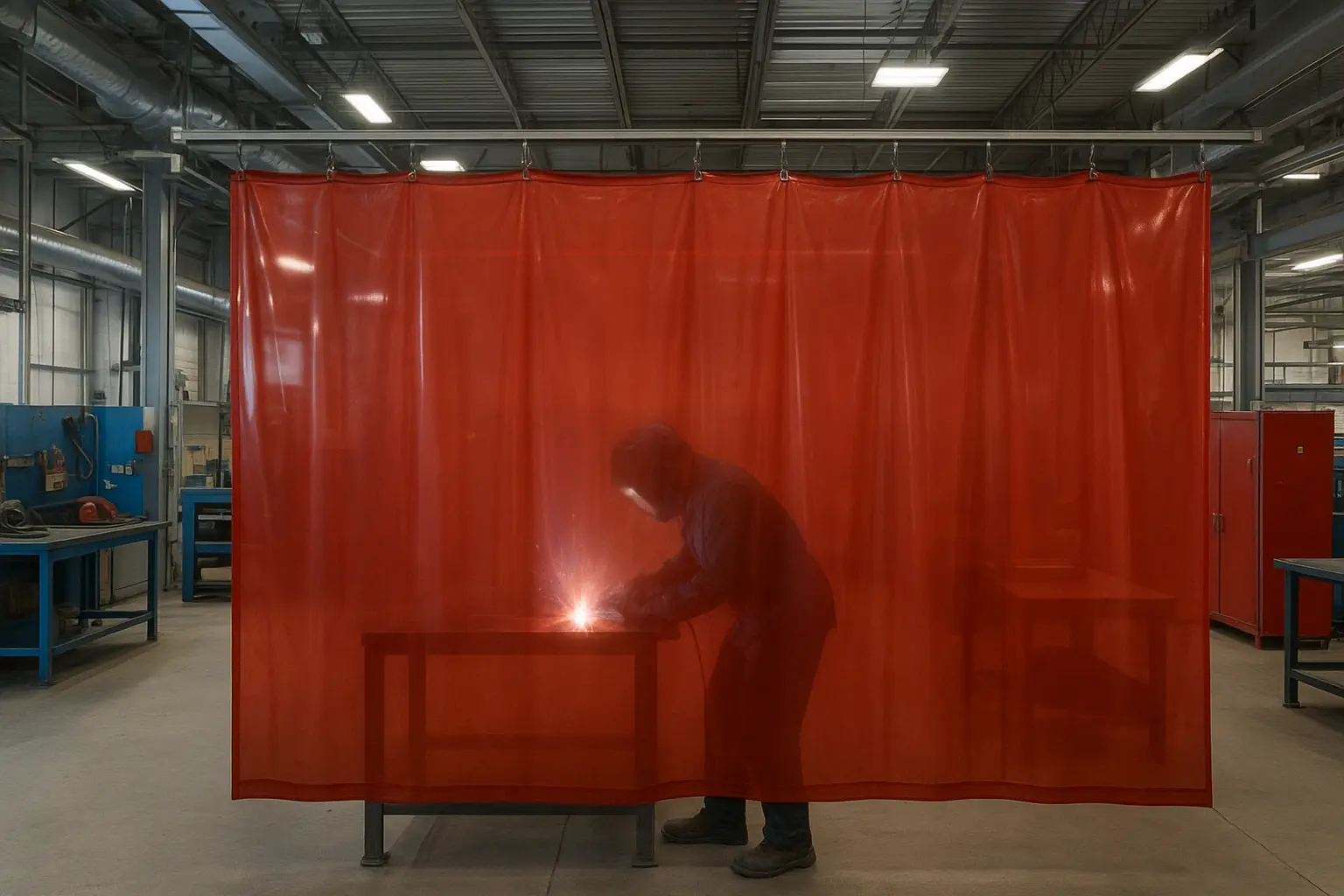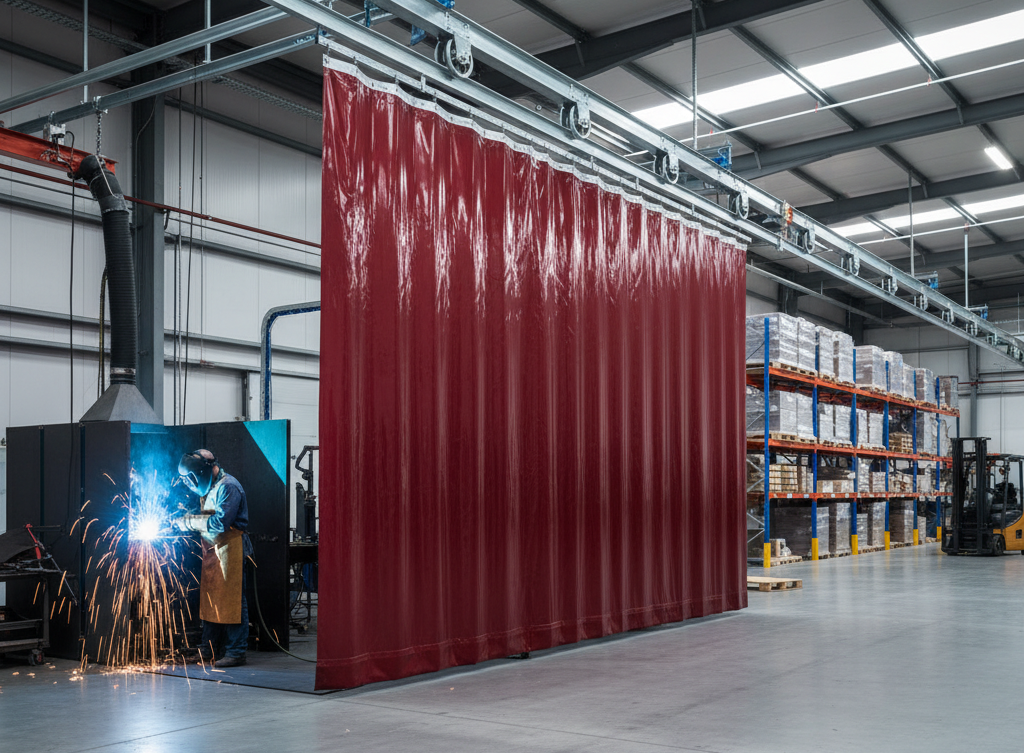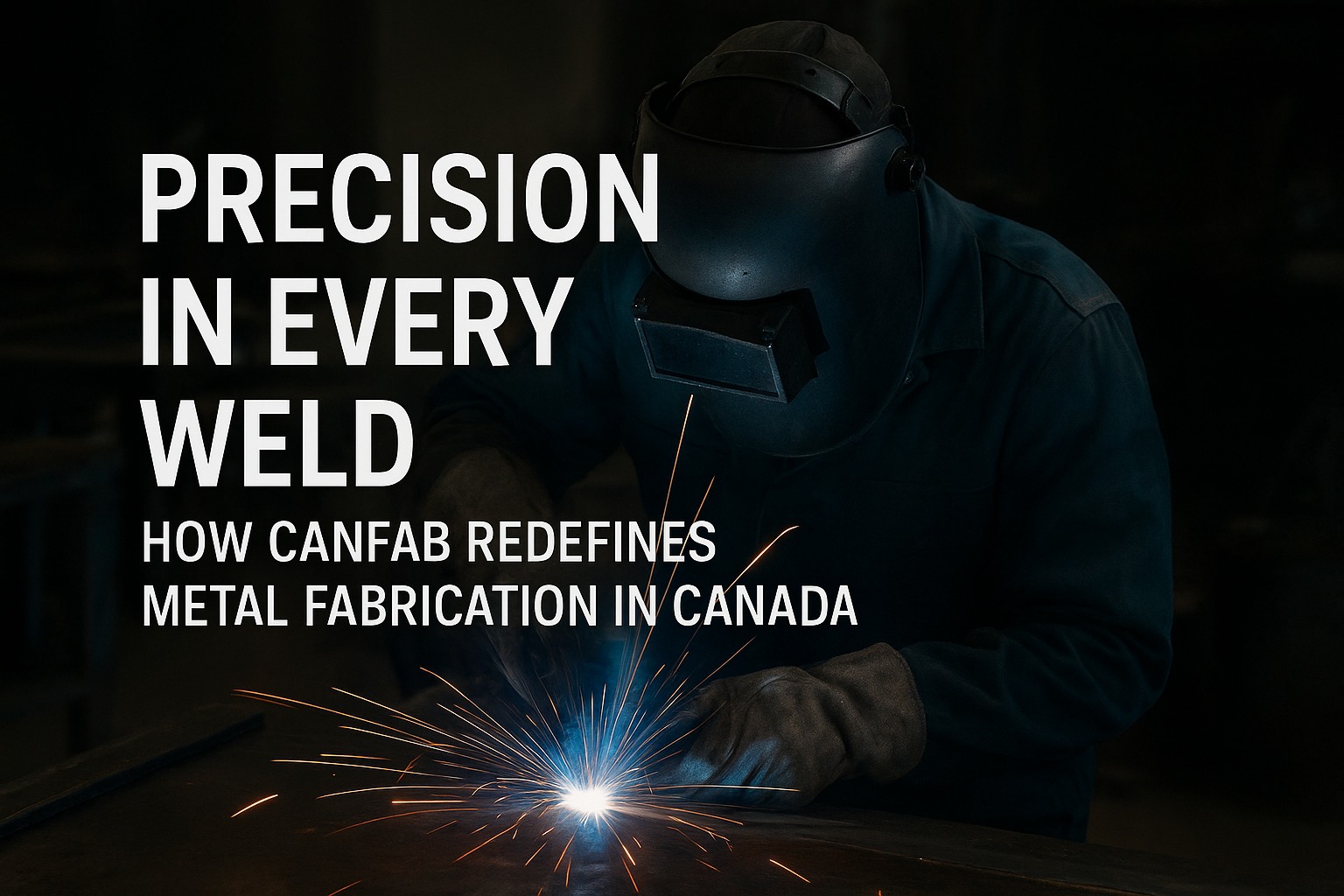In the demanding environment of modern industrial fabrication, welding processes, including shielded metal arc welding (SMAW), gas metal arc welding (GMAW), and plasma arc cutting (PAC), produce unavoidable hazards. Among the most immediate and dangerous risks to nearby personnel are invisible threats: harmful ultraviolet (UV) and blue light radiation from the electric arc. These silent hazards can cause severe, long-term physical injury, including “flash burns” or eye damage, impacting employee health, increasing liability exposure, and escalating operational downtime. Therefore, the installation of certified, heavy-duty welding curtains is not a choice, but a critical regulatory necessity and an immediate imperative for risk mitigation.
Canfab Products Ltd. is positioned as the Edmonton and Western Canada expert in custom fabrication, offering solutions that adhere to the most rigorous national and provincial safety codes. The comprehensive approach addresses three core pillars essential for maximizing worker safety and ensuring compliance: navigating complex regulatory mandates, selecting technically superior material science, and guaranteeing professional custom installation. By understanding the deep technical specifications required for optical safety, fire resistance, and durability, industrial buyers can select protection solutions that guarantee longevity and minimize liability in the long term.
Regulatory Mandates: What Canadian OHS Requires for Worker Protection
For industrial operations in Western Canada, the purchase and deployment of safety screens must be anchored in specific legal and regulatory compliance. The regulatory framework transforms the industrial curtain from a simple physical barrier into a mandatory piece of safety equipment.
1. Federal and National Standards
The foundational national requirement for welding safety in Canada is detailed in CSA Standard W117.2: Safety in Welding, Cutting, and Allied Processes. This standard mandates comprehensive protective measures, including the requirement for welding screens to protect workers from physical hazards and radiation exposure. Compliance with CSA W117.2 dictates that screens must perform a dual safety function: primarily, they must shield surrounding workers from dangerous UV light and arc flashes. Secondarily, the screens must be integrated into the workspace design to minimize environmental risks, such as preventing cross-drafts that can scatter fumes and ensuring efficient fume capture and containment through proper ventilation. This emphasis on environmental control alongside optical protection demonstrates that safety curtains are intrinsic components of a holistic industrial health system.
2. Provincial Law: Alberta OHS Code Section 231
While national standards provide the baseline, provincial legislation dictates specific workplace requirements. The Alberta Occupational Health and Safety (OHS) Code provides specific technical rules for safety in Alberta workplaces. Section 231 of the OHS Code explicitly states that a worker must not perform electric arc welding if there is any reasonable possibility that another worker could be exposed to radiation from the arc, unless the exposed worker is protected by suitable personal protective equipment or a dedicated screen.
Citing this precise provincial code is essential for fabricators operating in Edmonton and servicing Western Canada. It directly addresses the legal burden carried by local industrial clients, positioning the supplier not just as a manufacturer but as a partner in regulatory adherence. This specificity ensures that the safety product is recognized as a necessary legal requirement solution, directly appealing to OHS managers and procurement specialists.
3. The Role of Manufacturers in Certification
While Canadian regulatory bodies like the CSA set performance mandates, manufacturers often rely on rigorous international testing methodologies to certify that their materials achieve the necessary protection levels. The absence of publicly accessible, detailed Canadian technical testing metrics means that high-quality fabricators must leverage established global benchmarks. For optical protection, this often includes adherence to standards such as the American standard, AWS F2.3M:2019, Specification for Use and Performance of Transparent Welding Curtains and Screens. This technical bridge demonstrates that the manufacturer has certified the right levels of optical and flame protection via testing in independent laboratories. To maintain compliance and traceability, certified screens must be clearly marked with the specific standard met, the manufacturer’s name, and the date of manufacture.
Material Science Deep Dive: Selecting the Right Vinyl for Optical and Fire Safety
The effectiveness of an industrial welding curtain hinges entirely on the quality and certification of its material. The specific properties of the vinyl (typically PVC) determine its ability to mitigate risk and endure harsh industrial environments.
1. Primary Threat: UV and Blue Light Radiation
The most critical function of a welding screen is to protect nearby personnel from the intense electromagnetic radiation emitted by the arc. This includes both harmful UV radiation and blue light radiation. Semitransparent vinyl materials are engineered to act as specialized optical filters, absorbing or reflecting these specific light wavelengths. Choosing the correct material ensures that the filter maintains line-of-sight for supervisory purposes while effectively blocking dangerous emissions.
2. The Critical Role of Optical Grading (VLT)
Welding screens and curtains are categorized into four standard grades based on their Visible Light Transmission (VLT). This grading system dictates the material’s color and thickness, which directly influences safety, bystander comfort, and the ease of supervision.
- Yellow Screens/Curtains (Grade L – Light): These screens offer the clearest visibility, allowing the most light into the welding booth. They are excellent for internal supervision and can reduce the sense of confinement for the welder. However, they carry a caution: the higher VLT can cause discomfort for bystanders continuously exposed to the light over several hours.
- Red Screens/Curtains (Grade M – Medium): These materials offer a critical compromise. They stop more visible light from transmitting through the screen but retain adequate transparency, allowing supervisors to monitor the operation and ensure the welder’s safety without causing undue eye strain or discomfort to others nearby.
- Green or Bronze Screens/Curtains (Grade D – Dark): These grades offer the lowest VLT, providing the maximum level of comfort for workers near the welding operation. While supervision is less easy than with lighter grades, it remains possible to confirm the welder is upright and operating equipment safely. This grade is often used when maximum bystander protection is required.
- Extra Dark (Grade ED): Typically matte green or a Shade 8 equivalent, this grade is primarily used to partition two adjacent welding booths where no direct line-of-sight supervision is needed. It transmits only enough partial welding light to indicate that an operation is active nearby.
It is essential to note that blue screens, while sometimes marketed for welding, are generally not suitable as they often fail to provide adequate protection against blue light radiation and cannot meet established welding safety standards.
Table Title
| Grade | Typical Color | VLT Implication | Best Application |
| Light (L) | Yellow | High Light Transmission | Clear visibility for occasional supervision |
| Medium (M) | Red | Balanced Transmission | General factory use; supervision with comfort |
| Dark (D) | Green / Bronze | Low Light Transmission | Maximum bystander comfort |
| Extra Dark (ED) | Matte Green / Shade 8 | Minimal Transmission | Partitioning between welder booths |
3. Fire Safety and Thermal Stability
Beyond optical protection, industrial welding curtains must withstand physical damage from sparks and spatter. This necessitates materials that meet rigorous fire safety standards. High-quality curtains are required to carry both NFPA (National Fire Protection Association) and CFM (California Fire Marshal) fire retardant certifications. This ensures the fabric will resist ignition and propagation of flame under extreme conditions.
Furthermore, given the extreme temperature variations in Western Canada, the material’s thermal stability is a critical factor in longevity. Heavy-duty 18oz vinyl material is commonly specified to handle temperatures ranging from as low as -20° F to 160° F. This superior thermal performance prevents the material from becoming brittle and cracking in severe cold or degrading rapidly under high heat exposure, guaranteeing functionality year-round.
Engineered Durability: Metrics That Define Commercial-Grade Performance
For industrial procurement, the Total Cost of Ownership (TCO) is a major factor. Investing in high-quality, durable materials that last longer reduces maintenance costs, replacement frequency, and liability exposure, ultimately maximizing return on investment.
1. The Lifespan Expectation
Industrial fabrics are explicitly designed for durability and are expected to pass heavy-duty ratings. Depending on the quality of the material, manufacturing standard, frequency of use, and adherence to upkeep practices, these fabrics are expected to last between 10 and 20 years. Choosing a manufacturer that prioritizes high-grade vinyl and robust construction aligns the fabrication product with modern industrial sustainability goals, moving away from low-cost, disposable solutions.
2. Abrasion Resistance Testing
The lifespan of a curtain or cover is often quantified by its resistance to friction and wear, primarily measured using abrasion tests.
- The Wyzenbeek Test: This measurement uses a mechanical arm to apply constant friction (double rubs) against the fabric until it shows signs of wear. For light-duty residential applications, a score of 3,000–9,000 double rubs is sufficient, but industrial applications require significantly higher performance. A fabric is considered heavy-duty if it withstands 25,000–30,000 double rubs, making it suitable for high-use commercial applications. Commercial grade materials exceed 30,000 double rubs, certifying them for the heaviest duty industrial use.
- The Martindale Test: An alternative but equally rigorous standard, the Martindale test measures durability using oscillating fabric disks. General contract upholstery requires 20,000 cycles, while materials classified as heavy duty upholstery must achieve 40,000 cycles.
It is important for buyers to recognize that durability is multi-faceted; factors beyond abrasion, such as tensile strength and proper maintenance, also govern the material’s long-term performance.
Table:
| Standard | Durability Rating | Minimum Requirement (Rubs/Cycles) | Application |
| Wyzenbeek | Medium Duty | 9,000–15,000 double rubs | Frequently used residential furniture |
| Wyzenbeek | Heavy Duty | 25,000–30,000 double rubs | High-use commercial environments |
| Martindale | General Contract | 20,000 cycles | Commercial upholstery |
| Martindale | Heavy Duty | 40,000 cycles | Industrial upholstery and high-wear areas |
3. Structural Integrity: Breaking Strength and Fabric Weight
For large industrial curtains, the material must resist tearing under tension, especially when suspended from ceiling tracks or subjected to cross-drafts. Industrial fabrics must meet a minimum breaking strength of 50 lbs to resist tearing, ensuring the structural integrity of the final product.
Material density is equally important. Many heavy-duty industrial curtains are constructed from 18 oz vinyl coated nylon for extra strength, often corresponding to 20 mil thickness. For extreme conditions or high-wear areas, super duty vinyl can reach 40 mil thickness (3.95 oz. per square foot), offering exceptional tear and puncture resistance. This heavy-grade material is often waterproof and UV-resistant, ensuring robust protection even during outdoor staging or transit.
Custom Fabrication: Tailored Solutions for Western Canada’s Toughest Environments
Canfab’s expertise in custom fabrication ensures that safety equipment is perfectly integrated into the existing operational layout, maximizing protection and efficiency.
1. Designing for the Application
Industrial safety equipment comes in two primary configurations: screens and curtains. Welding screens are typically semitransparent vinyl fixed on portable frames, providing flexibility for mobile welding operations or construction sites. Welding curtains, by contrast, are usually suspended from the ceiling or mounted semi-permanently on a structure, often utilized for dedicated, stationary welding booths.
For complex facilities across Western Canada, standard sizes are rarely sufficient. Custom-made solutions allow the fabricator to match the exact dimensions of machinery, provide tailored temporary enclosures, or divide large facilities with complex infrastructure. This precise fit ensures that every inch of the asset or work area is protected, minimizing environmental exposure risks.
2. Specialized Features for Industrial Use
A custom solution incorporates necessary features that generic off-the-shelf products often lack. These include the use of heavy-duty hardware, track and trolley systems, bottom pockets, reinforced grommets, and door inserts, all designed to support the weight and movement of 18 oz vinyl-coated nylon or heavier materials.
Furthermore, the materials employed in welding curtains overlap significantly with other critical industrial products, such as custom tarps and protective covers for the oil and gas sector. By manufacturing both product lines, the fabricator ensures a consistent, high-grade material base, whether the product is protecting workers from arc flash or shielding equipment from the harsh elements of the Alberta oil fields.
3. Beyond Welding: Wash Bay and Chemical Containment Curtains
The same rigorous material science and custom fabrication principles apply to related industrial applications, specifically wash bay and chemical containment curtains. In industries requiring frequent equipment cleaning, such as automotive or heavy equipment maintenance, these curtains act as reliable barriers. They are designed to contain water, debris, and chemical overspray during washdown processes, preventing cross-contamination and maximizing the utilization of shop floor space.
These heavy-duty containment solutions often employ the super duty 40 mil vinyl which is outdoor rated, NFPA fire retardant, and built to withstand exposure to chemicals and wide temperature fluctuations. The capability to produce both safety curtains and containment solutions under the same high standard demonstrates the fabricator’s broad, reliable expertise in vinyl-based industrial safety solutions.
Conclusion: Your Partner in Compliance and Longevity
The selection of industrial welding curtains is a decision driven by regulatory necessity (CSA W117.2, Alberta OHS Code 231) and economic foresight. Generic products may offer short-term savings, but they introduce unacceptable risks related to worker safety and regulatory non-compliance. A superior industrial safety solution requires materials certified for optical protection (using internationally recognized grading systems), confirmed fire retardancy, and quantifiable durability (exceeding 30,000 Wyzenbeek double rubs or 50 lbs breaking strength).
Canfab Products Ltd. leverages over 30 years of custom fabrication experience to deliver solutions that meet the specific operational demands and compliance requirements of Western Canadian industry. By providing tailored, heavy-duty vinyl curtains and screens, the company ensures that industrial facilities mitigate risks, achieve mandated safety levels, and gain a durable asset that reduces the long-term cost of ownership. Procurement specialists and OHS managers requiring a custom, compliant safety solution are encouraged to contact the Edmonton-based experts for a free consultation to ensure precise specifications and professional installation.



